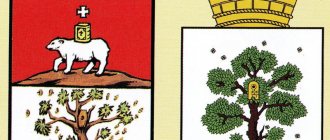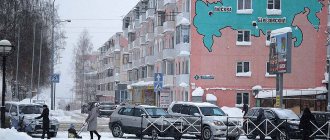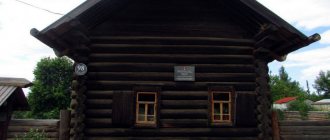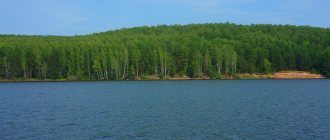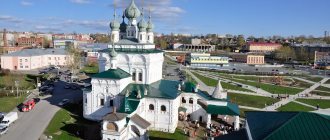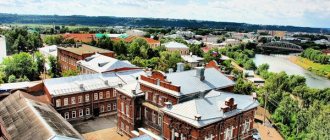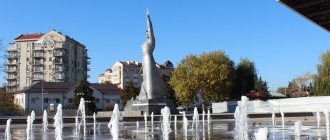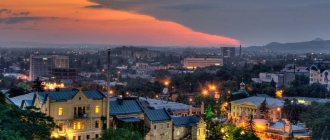Usman
(Lipetsk region)
OKATO code:
42248501
Founded:
1645
City since:
1645 City of district subordination (Usmansky district, Lipetsk region)
Center:
Usmansky district
Telephone code (reference phone)
| 47472***** | 22-2-22 |
Deviation from Moscow time, hours:
0
Geographic latitude:
52°03′
Geographic longitude:
39°44′
Altitude above sea level, meters:
140 Sunrise and sunset times in the city of Usman
Notes
- ↑ 123
www.gks.ru/free_doc/doc_2016/bul_dr/mun_obr2016.rar Population of the Russian Federation by municipalities as of January 1, 2016 - THE USSR. Administrative-territorial division of the union republics on January 1, 1980 / Compiled by V. A. Dudarev, N. A. Evseeva. - M.: Publishing house "Izvestia of the Soviets of People's Deputies of the USSR", 1980. - 702 p. — P. 165.
- Prokhorov V. A.
Lipetsk toponymy. - Voronezh: Central-Chernozemnoe book. publishing house, 1981. - P. 140. - 160 p. — 10,000 copies. - ↑ 123456789101112
[www.MojGorod.ru/lipeck_obl/usmanj/index.html People's encyclopedia “My City”. Usman]. Retrieved June 13, 2014. [www.webcitation.org/6QIyyRrUA Archived from the original on June 13, 2014]. - [demoscope.ru/weekly/ssp/rus59_reg2.php All-Union Population Census of 1959. The size of the urban population of the RSFSR, its territorial units, urban settlements and urban areas by gender] (Russian). Demoscope Weekly. Retrieved September 25, 2013. [www.webcitation.org/6GDOghWC9 Archived from the original on April 28, 2013].
- [demoscope.ru/weekly/ssp/rus70_reg2.php All-Union Population Census of 1970 The size of the urban population of the RSFSR, its territorial units, urban settlements and urban areas by gender.] (Russian). Demoscope Weekly. Retrieved September 25, 2013. [www.webcitation.org/6GDOiMstp Archived from the original on April 28, 2013].
- [demoscope.ru/weekly/ssp/rus79_reg2.php All-Union Population Census of 1979 The size of the urban population of the RSFSR, its territorial units, urban settlements and urban areas by gender.] (Russian). Demoscope Weekly. Retrieved September 25, 2013. [www.webcitation.org/6GDOjhZ5L Archived from the original on April 28, 2013].
- [demoscope.ru/weekly/ssp/rus89_reg2.php All-Union Population Census of 1989. Urban population]. [www.webcitation.org/617x0o0Pa Archived from the original on August 22, 2011].
- [www.perepis2002.ru/ct/doc/1_TOM_01_04.xls All-Russian Population Census 2002. Volume. 1, table 4. Population of Russia, federal districts, constituent entities of the Russian Federation, districts, urban settlements, rural settlements - regional centers and rural settlements with a population of 3 thousand or more]. [www.webcitation.org/65AdCU0q3 Archived from the original on February 3, 2012].
- [www.gks.ru/bgd/regl/B09_109/IssWWW.exe/Stg/d01/tabl-21-09.xls Number of permanent population of the Russian Federation by cities, urban-type settlements and districts as of January 1, 2009]. Retrieved January 2, 2014. [www.webcitation.org/6MJmu0z1u Archived from the original on January 2, 2014].
- [lipstat.gks.ru/wps/wcm/connect/rosstat_ts/lipstat/resources/d81ba08041487d4b814de7367ccd0f13/VPN2010_Number+and+placement+of population.pdf All-Russian Population Census 2010. Number and distribution of the population of the Lipetsk region]. Lipetskstat. Retrieved November 7, 2013. [www.webcitation.org/6Kwk9BYKw Archived from the original on November 7, 2013].
- www.gks.ru/dbscripts/munst/munst42/DBInet.cgi?pl=8112027 Lipetsk region. Estimated resident population as of January 1, 2009-2016
- [www.gks.ru/free_doc/doc_2012/bul_dr/mun_obr2012.rar Population of the Russian Federation by municipalities. Table 35. Estimated resident population as of January 1, 2012]. Retrieved May 31, 2014. [www.webcitation.org/6PyOWbdMc Archived from the original on May 31, 2014].
- [www.gks.ru/free_doc/doc_2013/bul_dr/mun_obr2013.rar Population of the Russian Federation by municipalities as of January 1, 2013. - M.: Federal State Statistics Service Rosstat, 2013. - 528 p. (Table 33. Population of urban districts, municipal districts, urban and rural settlements, urban settlements, rural settlements)]. Retrieved November 16, 2013. [www.webcitation.org/6LAdCWSxH Archived from the original on November 16, 2013].
- [www.gks.ru/free_doc/doc_2014/bul_dr/mun_obr2014.rar Table 33. Population of the Russian Federation by municipalities as of January 1, 2014]. Retrieved August 2, 2014. [www.webcitation.org/6RWqP50QK Archived from the original on August 2, 2014].
- [www.gks.ru/free_doc/doc_2015/bul_dr/mun_obr2015.rar Population of the Russian Federation by municipalities as of January 1, 2015]. Retrieved August 6, 2015. [www.webcitation.org/6aaNzOlFO Archived from the original on August 6, 2015].
Map
| Usman: maps |
Usman: photo from space (Google Maps) Usman: photo from space (Microsoft Virtual Earth)
| Usman. Nearest cities. Distances in km. on the map (in brackets along roads) + direction. Using the hyperlink in the distance , you can get the route (information courtesy of the AutoTransInfo website) | |||
| 1 | Upper Hawa (Voronezh region) | 26 (30) | SE |
| 2 | Ramon (Voronezh region) | 30 (128) | SW |
| 3 | Volya (Voronezh region) | 35 () | SW |
| 4 | Khlevnoe | 46 (84) | Z |
| 5 | Borinskoe | 51 () | NW |
| 6 | Mud | 51 (57) | WITH |
| 7 | Dobrinka | 51 (86) | IN |
| 8 | Novaya Usman (Voronezh region) | 51 (91) | SW |
| 9 | Panino (Voronezh region) | 53 (59) | SE |
| 10 | Voronezh | 56 (113) | SW |
| 11 | Lipetsk | 62 (90) | WITH |
| 12 | Semiluki | 63 (124) | SW |
| 13 | Zadonsk | 66 (190) | NW |
| 14 | Mordovo (Tambov region) | 70 (121) | IN |
| 15 | Kashirskoye (Voronezh region) | 71 (121) | YU |
| 16 | Latnaya (Voronezh region) | 72 (127) | SW |
| 17 | Petrovskoye (Tambov region) | 73 (89) | NE |
| 18 | Ertil | 76 (118) | IN |
| 19 | Anna (Voronezh region) | 78 (174) | SE |
| 20 | Khokholsky (Voronezh region) | 82 (157) | SW |
| 21 | Kolodezny (Voronezh region) | 83 (147) | YU |
| 22 | Novovoronezh | 88 (152) | SW |
| 23 | Kind | 90 () | WITH |
| 24 | Tokarevka (Tambov region) | 98 (155) | IN |
| 25 | Dolgorukovo | 98 (254) | Z |
| 26 | Terbuny | 99 (224) | Z |
| 27 | Davydovka (Voronezh region) | 101 (154) | YU |
| 28 | Dace | 103 (122) | NW |
| 29 | Zavoronezhskoe (Tambov region) | 107 (125) | NE |
| 30 | Michurinsk | 107 (127) | NE |
a brief description of
The city is located within the Oka-Don Plain, on the river. Usman (left tributary of the Voronezh River, Don basin), 75 km south of Lipetsk. Railway station. Road junction.
Territory (sq. km): 12
Information about the city of Usman on the Russian Wikipedia site
Historical sketch
Founded in 1645 “by order of the sovereign” by governor Stepan Velyaminov as a fort on the Belgorod defensive line. Name by river Usman (left tributary of Voronezh); hydronym from Old Iranian asman “stone”.
In 1652 it was subjected to a devastating raid by the Tatars.
And in 1708 it was assigned to the Azov province (from 1725 - Voronezh province), from 1719 to the Voronezh province. Since 1779, the district town of Usman of the Tambov governorship (since 1796 - Tambov province).
In 1856, in the district town of Usman, Tambov province, there were 5 churches, 600 houses, 90 shops.
At the end of the 19th - beginning of the 20th centuries. Usman is the center of grain trade (more than 1 million poods of grain were sent to Moscow and exported annually), the production of shag, and the sale of horses from local horse breeding.
Economy
Foundry equipment plant, tobacco factory, etc.
Usman is the center of an agricultural region (wheat and makhorka crops; meat and dairy farming).
Culture, science, education
Museum of Local Lore.
Museums, galleries, exhibition halls
Usman Regional Museum of Local Lore 399340, Lipetsk region, Usman district, Usman, st. Lenina, 35 Phone(s): (47472) 2-1572 2-1672
| Population by year (thousands of inhabitants) | |||||||
| 1856 | 5.5 | 1979 | 20.1 | 2006 | 19.5 | 2016 | 19.8 |
| 1897 | 10.0 | 1989 | 20.9 | 2007 | 19.4 | 2017 | 20.0 |
| 1913 | 12.7 | 1992 | 21 | 2008 | 19.4 | 2018 | 20.0 |
| 1926 | 7 | 1996 | 21.2 | 2010 | 19.4 | 2019 | 19.7 |
| 1931 | 13.6 | 1998 | 21.0 | 2011 | 18.7 | 2020 | 19.6 |
| 1939 | 11.4 | 2000 | 20.8 | 2012 | 18.8 | 2021 | 19.4 |
| 1959 | 11.9 | 2001 | 20.6 | 2013 | 19.1 | ||
| 1967 | 16 | 2003 | 20.1 | 2014 | 19.4 | ||
| 1970 | 20.2 | 2005 | 19.6 | 2015 | 19.7 | ||
History of Usman
As we enter the city, we see a sign. It shows the year of Usman's founding.
In 1645, the governor Stepnoy Vasilyevich Velyaminov built a fortress. Little is known about this man. He served at the royal court for a year, was a commander in Belev and another city that has not been on the map of Russia for a long time, and in February 1645 he received an order to build Usman. And it seems that already in April, as soon as the snow melted, he laid the first stone in the foundation of the fortress. Here Velyaminov spent three years, after which he left for Yablonov (until 1779, a city, now the village of Yablonovo in the Belgorod region).
The construction of the fortress became part of a plan to protect Moscow from enemy raids, which became more frequent in the forties. The order said: to build a residential fort on the Usman River. Hence the name of the city. On the river, in addition to Usman, there are several settlements, including the village of Novaya Usman, founded in 1598.
For the first fifty years of its history, Usman remained a strategic site. In 1701, it came under the jurisdiction of the Admiralty Prikaz, which was engaged in the ship construction of the Azov Fleet. When the ship construction was completed, and the fortress functions of Usman lost their relevance, the appearance of the city also changed. Agriculture and trade began to develop. More residential buildings appeared. Meanwhile, the fortifications were deteriorating (by 1780, only a shallow ditch and an earthen rampart remained).
There are interesting sights in the Lipetsk region, which, alas, are not suitable for photo sessions. One of them is the same Usman earthen rampart. It is also called Tatar.
In 1790, the first stone temple was built in Usman. In its place today is the Epiphany Cathedral (at Voevody Velyaminov St., 20a). The temple, of course, was demolished, rebuilt, and restored more than once.
19th century
In 1802, Usman became a district town. Thirty years later, redevelopment began. The city grew, and stone commercial and residential buildings appeared. In the middle of the century, five and a half thousand people lived in Usman, which is quite a bit by modern standards (according to 2018, the city’s population is twenty thousand people).
In 1821, the first school opened in Usman. At the beginning of the next century - a women's gymnasium and a real school.
Women's gymnasium
The city park (photo below) was laid out on a vacant lot in 1875. Then, of course, he looked completely different.
By the nineties, Usman had become a typical Russian merchant city. It retained its appearance by the end of the 19th century until the October Revolution.
The mystery of the name "Usman"
Turning to the toponymic legends of the past allows us to look into the depths of bygone centuries, when the Novy Usman land was inhabited by Turkic-speaking nomadic tribes. These tribes gave names to many rivers in our region.
Toponymic legends are not an entertaining, but an educational genre of folklore. For a long time it was of interest only to historians and ethnographers, and only very recently folklorists also turned their attention to it.
When comparing folk and scientific etymology, it turns out that in most cases there is always a share of fiction. Here folk imagination manifests itself with particular force. In general, Voronezh toponymic legends are distinguished by the originality of their plot and composition, and the Mongol-Tatar cycle is of particular interest to us. I will cite two such legends - they can be called pure fiction.
“A long time ago, a khan lived in our region, and he had a very beautiful daughter named Usmanka. And she fell in love with a Russian guy. But her father was against this love, and the girl drowned in the river out of grief. The river got its name from this girl.” Another similar legend: “The daughter of the Mongol-Tatar khan Usmanka drowned in the river, and the river was named after her.”
Photo: Mikhail Nebolsin
Perhaps the name is related to the location of the river, which runs along the large Usman forest. From historical documents we clearly see that the Usman forest waged a centuries-long struggle with the steppe along the Usman River: either the steppe ran onto the right bank of the river, forming hollow places, or the forest spread across the river, to the left bank, deepening in large wedges to the east into the steppe expanses . This feature was historically reliably noted by I. S. Nikitin in his poem “Fist”:
...Long ago, in the harsh wilderness, the oak forest rustled here menacingly, spoke with the desert wind, and an eagle swam in the clouds...
Excerpt characterizing Usman
One minute, when everything was quiet on the stage, waiting for the start of the aria, the entrance door of the stalls creaked, on the side where the Rostovs’ box was, and the steps of a belated man sounded. “Here he is Kuragin!” Shinshin whispered. Countess Bezukhova turned to the newcomer, smiling. Natasha looked in the direction of Countess Bezukhova’s eyes and saw an unusually handsome adjutant, with a self-confident and at the same time courteous appearance approaching their bed. It was Anatol Kuragin, whom she had seen for a long time and noticed at the St. Petersburg ball. He was now in an adjutant uniform with one epaulette and a bracelet. He walked with a restrained, dashing gait, which would have been funny if he had not been so handsome and if there had not been such an expression of good-natured contentment and joy on his beautiful face. Despite the fact that the action was going on, he, slowly and slightly rattling his spurs and saber, smoothly and high holding his perfumed beautiful head, walked along the carpet of the corridor. Looking at Natasha, he walked up to his sister, put his gloved hand on the edge of her box, shook her head and leaned over and asked something, pointing at Natasha. - Mais charmante! [Very sweet!] - he said, obviously about Natasha, as she not so much heard as understood from the movement of his lips. Then he walked to the front row and sat down next to Dolokhov, giving a friendly and casual elbow to Dolokhov, whom the others were treating so ingratiatingly. He smiled at him with a cheerful wink and rested his foot on the ramp. – How similar brother and sister are! - said the count. - And how good they are both! Shinshin began to tell the count in a low voice some story of Kuragin's intrigue in Moscow, to which Natasha listened precisely because he said charmante about it. The first act ended, everyone in the stalls stood up, got confused and began to walk in and out. Boris came to the Rostovs' box, very simply accepted congratulations and, raising his eyebrows, with an absent-minded smile, conveyed to Natasha and Sonya his bride's request that they be at her wedding, and left. Natasha talked to him with a cheerful and flirtatious smile and congratulated the same Boris with whom she had been in love before on his marriage. In the state of intoxication in which she was, everything seemed simple and natural. Naked Helen sat next to her and smiled equally at everyone; and Natasha smiled at Boris in the same way. Helen's box was filled and surrounded from the stalls by the most distinguished and intelligent men, who seemed to be vying to show everyone that they knew her. Throughout this intermission, Kuragin stood with Dolokhov in front of the ramp, looking at the Rostovs’ box. Natasha knew that he was talking about her, and it gave her pleasure. She even turned around so that he could see her profile, in her opinion, in the most advantageous position. Before the start of the second act, the figure of Pierre appeared in the stalls, whom the Rostovs had not seen since their arrival. His face was sad, and he had gained weight since Natasha last saw him. Without noticing anyone, he walked into the front rows. Anatole approached him and began to say something to him, looking and pointing at the Rostovs’ box. Pierre, seeing Natasha, perked up and hurriedly, along the rows, went to their bed. Approaching them, he leaned on his elbow and, smiling, spoke to Natasha for a long time. During her conversation with Pierre, Natasha heard a man’s voice in Countess Bezukhova’s box and for some reason learned that it was Kuragin. She looked back and met his eyes. Almost smiling, he looked straight into her eyes with such an admiring, affectionate look that it seemed strange to be so close to him, to look at him like that, to be so sure that he liked you, and not be familiar with him. In the second act there were paintings depicting monuments and there was a hole in the canvas depicting the moon, and the lampshades on the ramp were raised, and trumpets and double basses began to play, and many people in black robes came out to the right and left. People began to wave their arms, and in their hands they had something like daggers; then some other people came running and began to drag away that girl who had previously been in a white, and now in a blue dress. They didn’t drag her away right away, but sang with her for a long time, and then they dragged her away, and behind the scenes they hit something metal three times, and everyone knelt down and sang a prayer. Several times all these actions were interrupted by enthusiastic screams from the audience. During this act, every time Natasha glanced at the stalls, she saw Anatoly Kuragin, throwing his arm over the back of the chair and looking at her. She was pleased to see that he was so captivated by her, and it did not occur to her that there was anything bad in this. When the second act ended, Countess Bezukhova stood up, turned to the Rostovs' box (her chest was completely bare), beckoned the old count to her with a gloved finger, and, not paying attention to those who entered her box, began to speak kindly to him, smiling. “Well, introduce me to your lovely daughters,” she said, “the whole city is shouting about them, but I don’t know them.” Natasha stood up and sat down to the magnificent countess. Natasha was so pleased by the praise of this brilliant beauty that she blushed with pleasure. “Now I also want to become a Muscovite,” said Helen. - And aren’t you ashamed to bury such pearls in the village! Countess Bezukhaya, rightly, had a reputation as a charming woman. She could say what she did not think, and especially flatter, completely simply and naturally. - No, dear Count, let me take care of your daughters. At least I won't be here for long now. And you too. I will try to amuse yours. “I heard a lot about you back in St. Petersburg, and I wanted to get to know you,” she told Natasha with her uniformly beautiful smile. “I heard about you from my page, Drubetsky. Did you hear he's getting married? And from my husband’s friend Bolkonsky, Prince Andrei Bolkonsky,” she said with special emphasis, thereby hinting that she knew his relationship to Natasha. “She asked, in order to get to know each other better, to allow one of the young ladies to sit in her box for the rest of the performance, and Natasha went over to her.
Secrets of the name “Usman”
Vesti-Lipetsk found out where the beautiful name of the city came from
Probably every resident and guest of Usmani wondered: Where did such a strange and at the same time beautiful name of the city come from? This question is not easy to answer, since there are many versions. Some are legendary, others are speculative, and others are historically reliable.
Usmanka's unrequited love
Photo source: pinterest. ch
There is a legend that connects the appearance of the name of the area with the khan’s daughter Usmanka. According to it, on the site of the modern city, a Tatar tribe once lived, and its leader had a beautiful daughter, Usmanka. She fell in love with a Russian guy, but her father was against this relationship. Out of grief, Usmanka threw herself into the river. From there they began to call the river Usman, which allegedly means “beauty” from Tatar.
Having heard such a legend, the Decembrist poet Odoevsky wrote a poem comparing the Usman River with a wayward and flirtatious beauty.
However, according to historian Boris Knyazhinsky, the legend of the drowned girl, although beautiful, is hardly plausible. In the Turkic language, the word “Usman” has a different meaning than “beauty”.
It is possible that this toponym was based on the name of the Mongol-Tatar prince who once roamed here, since among the Turkic-speaking peoples the name Usman or Osman is still common.
Alternative versions
Usmanka River (photo source: yandex.ru)
Some scientists are inclined to consider “Usman” not a Turkic word, but an Iranian word “asman”, meaning stone. Local historian Vladimir Prokhorov suggests that the name of the area was brought here in the 10th century by the Slavs who moved to the Don region from the Chernigov land, where there was a river with the same name and a rocky bottom.
However, Prokhorov's version remains controversial in academic circles. The fact is that the word “asman” has many meanings and pronunciation options. One of the analogues of the word “asman” can be the Turkic word “usman” - “to grow”, “growing”, which could form the basis for the name of the river. Perhaps the name is related to the location of the river, which runs along the large Usman forest.
Usmansky pine forest (photo source: infourok.ru)
Also, some scientists have tried to connect Usman with the Finnish word “usma”, meaning fog. However, no one was able to prove this assumption.
Slavic origin
Slavic settlement (photo source: centr-intellect.ru)
According to another version, which is followed by most historians and scientists, the name of the area was given by Slavic tribes who lived in the 8th-10th centuries along the banks of Voronezh, Don and Matyra. As Voronezh historian Vladimir Zagorsky suggests, the river was originally called “Usmyn” or “Osmon”. In the explanatory dictionary V.I. Dahl comes across the Russian word “usma” - tanned leather. Some researchers believe that in this area, Slavic tribes hunted and tanned the skins of killed animals.


